Motorola Droid Bionic Review - Dual Core with 4G LTE
by Brian Klug on October 11, 2011 1:55 AM EST- Posted in
- Smartphones
- LTE
- Motorola
- OMAP 4
- Mobile
- motorola droid bionic
Software and Performance
The Bionic comes with Motorola’s new Motoblur, just like I saw on the Droid 3. You can go pull the specific version from build.prop:
Blur_Version.5.5.886.XT875.Verizon.en.US
It includes a custom lock screen which gets some different styling and a slide left-right unlock scheme. The theme also includes an CRT off animation, which seems to be an approximation of the off animation from Android 2.3. The Bionic as we reviewed it was running Android 2.3.4, which is new but not absolute bleeding edge.
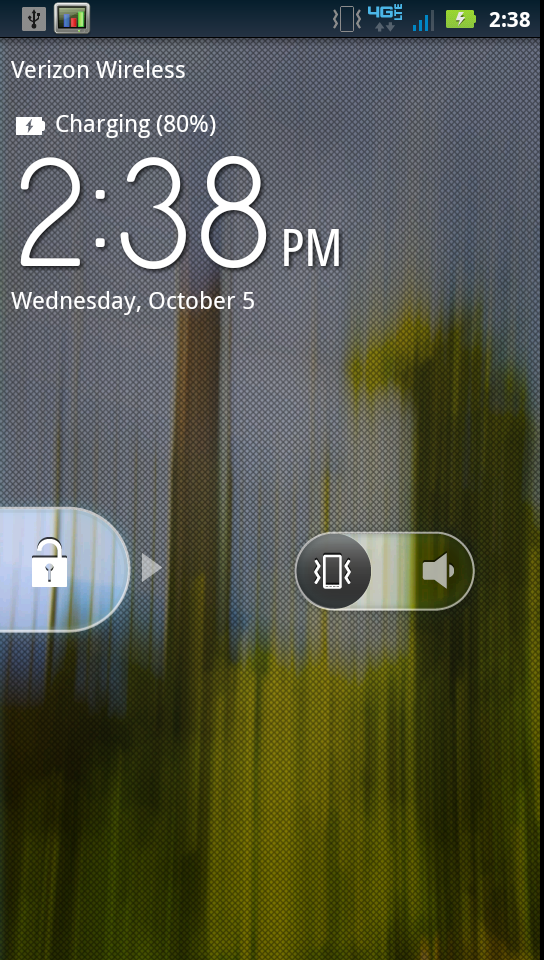
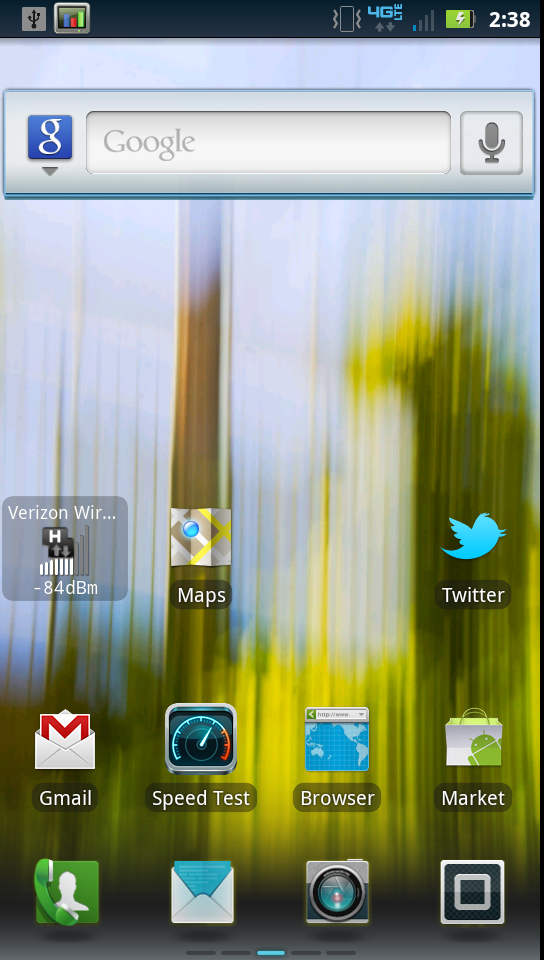
All the usual Motoblur accoutrements are here, including a black on grey theme for settings and menus, and blue elsewhere for the shade and highlighting colors.

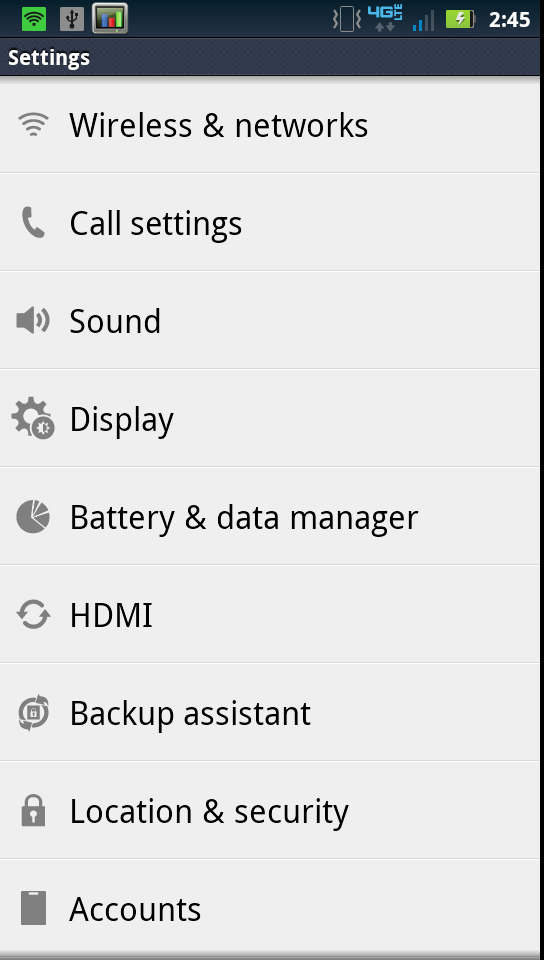
The home screens get the same kind of 3D composition I saw on the Droid 3, and feel pretty smooth panning back and forth. The only thing I’ve noticed this time is that it looks like the color depth here on the background seems to be 16 bit (RGB 565). I bet this is due to some GPU composition going on which makes things nice and speedy.
Pretty much the same applies to the launcher, where you get a paginated 4x5 grid of icons that can be sorted alphabetically or grouped. The Bionic does come with an assortment of preloaded stuff that’s entirely par for Verizon. Some things can be removed without root, other things can’t. I feel like we’re getting closer to the point where users are given the ability to uninstall stuff without root, but it still isn’t here yet.
Going over the storage situation on the Droid 3 is also important. By default, you get 16 GB of internal NAND, and a 16 GB class 4 microSD card. Things look like this using df:
Filesystem Size Used Free Blksize/dev 465M 388K 465M 4096/mnt/asec 465M 0K 465M 4096/mnt/obb 465M 0K 465M 4096/system 477M 332M 144M 1024/data 3G 501M 3G 4096/cache 708M 18M 689M 4096/osh 1G 650M 661M 2048/pds 3M 1M 2M 1024/preinstall 302M 187M 115M 1024/mnt/sdcard-ext 14G 11M 14G 32768/mnt/sdcard-ext 14G 11M 14G 32768/mnt/sdcard 8G 227M 7G 8192/mnt/sdcard 8G 227M 7G 8192
I’m not going to go over all of the OMAP 4430 details again since we’ve already gone in depth with the Motorola Droid 3, so I’d encourage curious minds to check that out for more detail. The short of it is that the Droid Bionic has a 1.0 GHz OMAP4430 SoC which consists of two ARM Cortex A9s with the MPE (ARM’s NEON SIMD unit), alongside PowerVR SGX 540 graphics at 304 MHz and a dual channel LPDDR2 memory interface. The Bionic has 1 GB of LPDDR2 over the Droid 3’s 512 MB of LPDDR2, but this is primarily to accommodate the increased demands from the laptop dock.
First up are the web based tests. Interestingly enough the Bionic posts an impressive result for SunSpider 0.9, I ran this test a few times as always and this wasn’t an errata. I also updated the SGS2 results with a run from the newest firmware I see on Kies, XXKI1, which is 2.3.4.
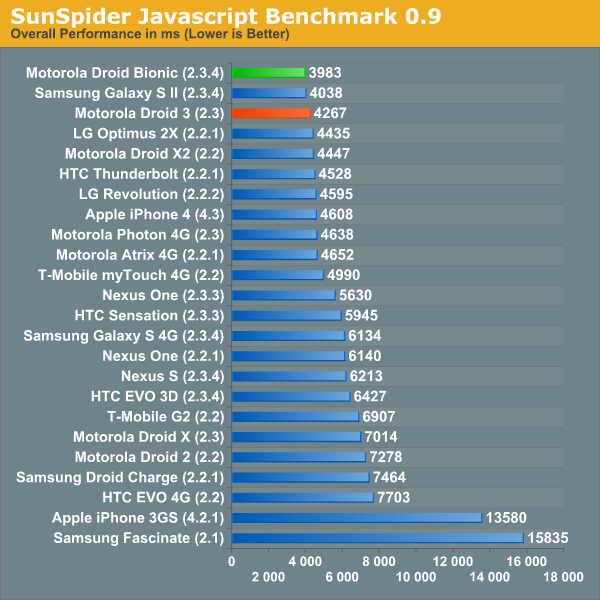
Browsermark curiously is a bit lower compared to the Droid 3 however, which is surprising since the two should be close considering the same SoC and version of Android. The results are reasonably close, however.
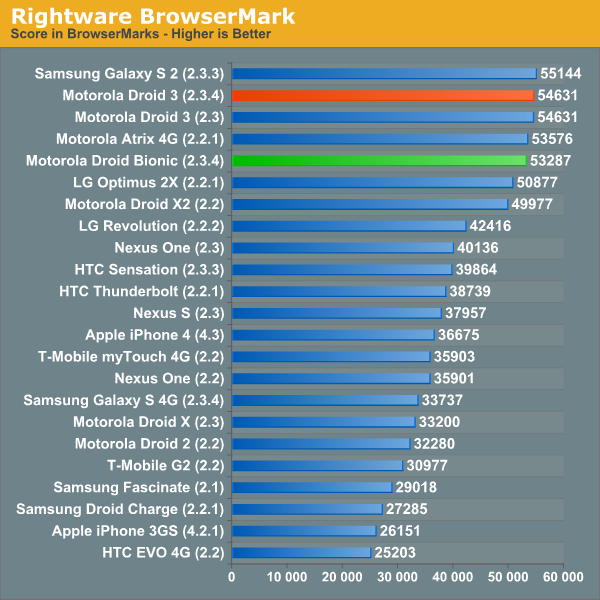
I didn’t record the Vellamo ocean flinger result from the Droid 3, however the Bionic comes in just above the Galaxy S 4G. Motorola isn’t using a backing store, rather something of a re-skinned stock Android browser, and thus scrolling performance isn’t as fluid as other devices.
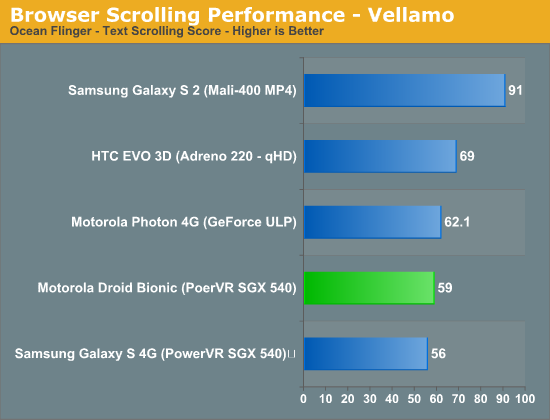
Flash is a bit interesting - there was an update for Flash 10.3 on Android pushed out a while back that enabled NEON codepaths for OMAP4 based phones. I didn’t have the Droid 3 at the time, but the Bionic now shows an improvement and is much closer to the cap for most of the test.

The rest of the tests are essentially the same as what we posted in the Droid Bionic preview piece, and reflect what we’ve seen before from OMAP4430.
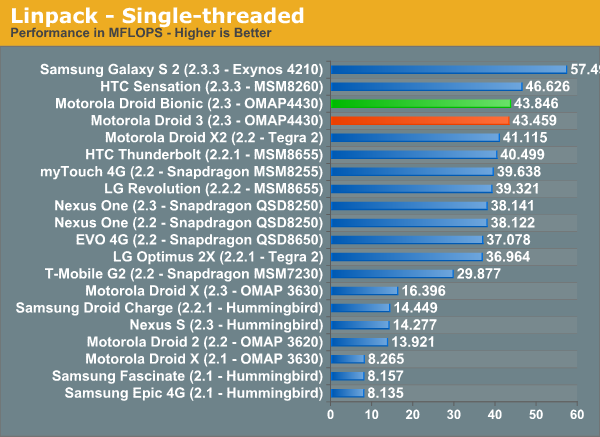
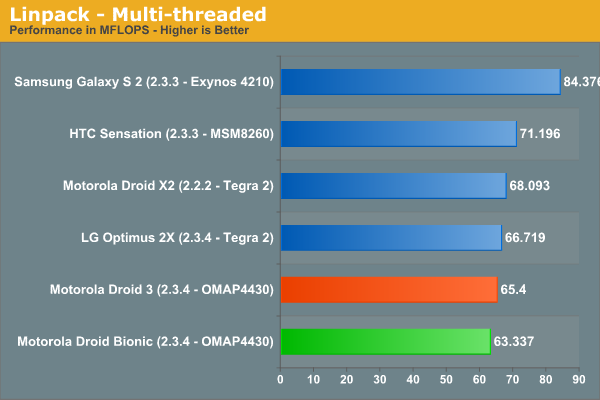
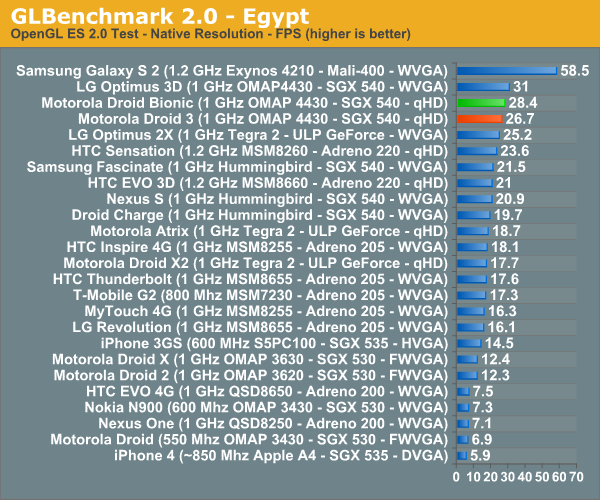
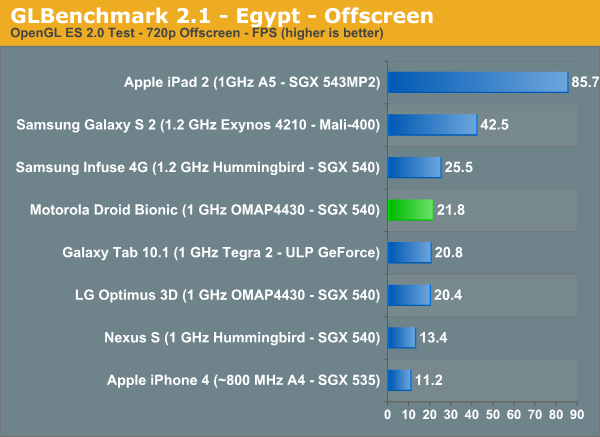
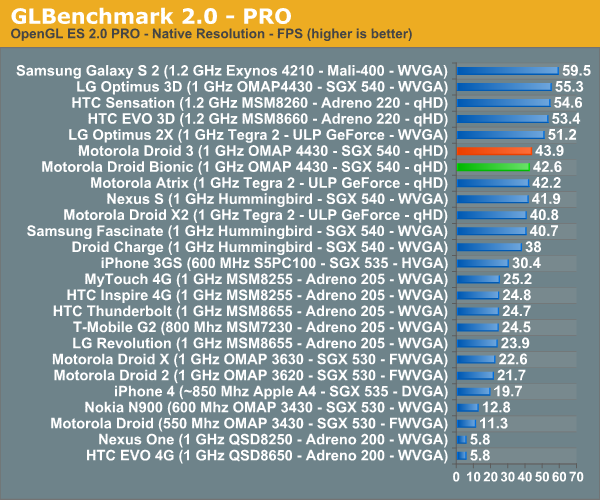
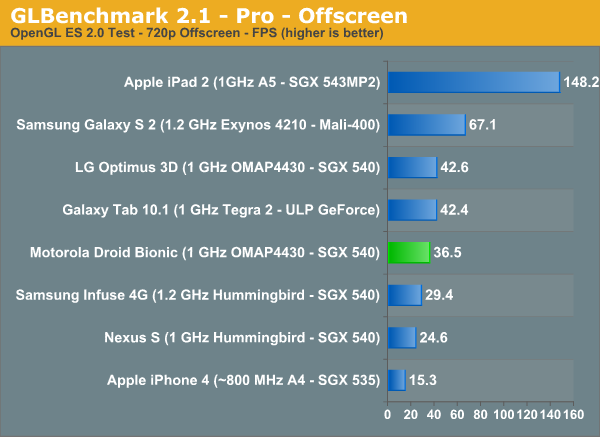
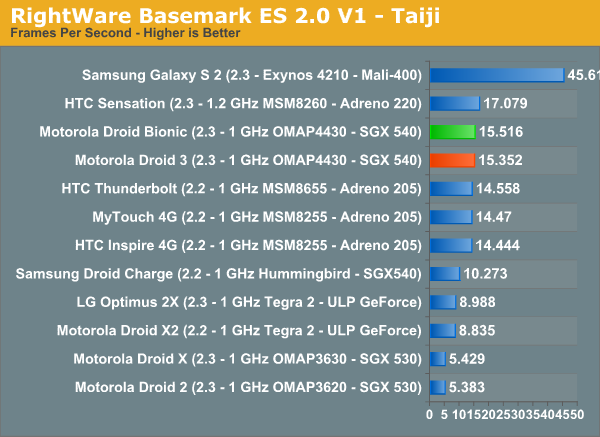
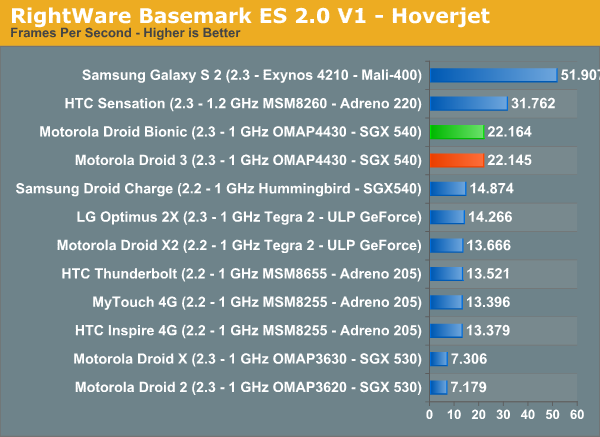
The results are unsurprising and completely in line with where they should be. The Bionic isn’t the absolute fastest of the dual core smartphones we’ve seen before, but it’s the first with LTE alongside it. The other question is how fast pages load on LTE compared to EVDO, I shot some video in our video review which really communicates things nicely.










64 Comments
View All Comments
steven75 - Tuesday, October 11, 2011 - link
Except for the waiting for your battery to charge, as proven in the tests above.Omega215D - Tuesday, October 11, 2011 - link
Not all of us have that issue with LTE. Granted the battery life isn't something worth writing home about but it's sufficient, especially after receiving Gingerbread on my Thunderbolt. On my original Droid and my brother's iPhone 4 there were times when the system would be pegging the EVDO constantly when loading some web pages thus putting more strain on the battery.kepler - Tuesday, October 11, 2011 - link
I would be interesting to see how much data is consumed during the tests. If the LTE phone is consuming 4x the data, but lasting half the time, that is arguably 2x increase in possible productivity.Aikouka - Tuesday, October 11, 2011 - link
I'm assuming that there isn't much difference between the data. LTE modems simply seem to be power hungry, so running a constant stream of data will show pretty high battery use.This knowledge is good for some users, because for people that like to stream things like Pandora, they may consider turning off LTE (LTE isn't really required for streaming music). But what came to my mind while reading the article is that **constant data use tests** don't necessarily mimic the actions that all users take.
It'd be interesting if we could see power characteristics related to a single action. For example, how many YouTube videos could I load throughout a single charge of the battery? If the LTE-equipped phones can load 200 vs. 50 on EVDO (completely made-up numbers) simply because LTE provides significantly faster speeds, then that shows a rather large multimedia advantage.
Even without such a test, I think it's pretty easy to see that while LTE is pretty amazing to see in a phone... there's a lot of micro-managing that you may have to consider doing to see the sort of battery life that we've come to expect out of a phone.
secretmanofagent - Tuesday, October 11, 2011 - link
One thing that I would like to point out (and I think it's specific to Blur and worth mentioning) is the ability to dismiss individual notifications instead of having to open each individual notification or clearing all of them. I love that feature on the Bionic.I have seen some data connectivity issues with it where I will randomly lose all data and be unable to recover it until I reboot the phone (airplane mode doesn't fix it). This can happen at any point in the day or night, and I'm having my phone exchanged.
anandtech pirate - Tuesday, October 11, 2011 - link
nah, that's okay. we don't wanna see your face.... :-palmost all phone reviews only show the phone which is what people are watching to see.
LordConrad - Tuesday, October 11, 2011 - link
My Thunderbolt is rooted and running Andriod 2.3.4, courtesy of Das BAMF 3.0 RC4.9 rom.I've overclocked it from 1.0GHz to 1.2GHz
A few benchmark results:
Sunspider = 3092ms
GUImark 2 (fullscreen) = 48.32
LinPack (single-thread) = 44.831
GLbench 2.1 Egypt = 18.2
I'll stay with this until Qualcomm Krait gets here. Besides, I would much rather have a TFT screen at WVGA than a Pentile screen at qHD.
Omega215D - Tuesday, October 11, 2011 - link
Let's see what the Samsung Prime and the HTC Vigor have in store for us now that they are using HD screens.I have the OTA Gingerbread on my Thunderbolt. I get similar results without rooting or overclock. Battery life is longer as well. I just have to avoid downloading useless apps from the market though (thanks to a certain APK).
LordConrad - Tuesday, October 11, 2011 - link
I'm looking forward to the HTC Vigor also. I don't care for Samsung devices, the screens are nice but they feel cheap and are not as easy to root as newer HTC phones. The Thunderbolt was annoying to root and I'm not doing that again.I forgot to mention that I got the 3200mah extended battery from Seidio Online shortly after buying the phone. Also, the main purpose of rooting was to enable programs such as WiFi Tether. I refuse to pay an extra $30 for tethering since I never exceed my phone's 2GB data plan (tethering is only occasional).
jeepdinger - Tuesday, October 11, 2011 - link
I would be curious to see the number of times each page loads when the battery test is run. It was stated that several pages load continuously during the test. The new LTE speeds versus the slower 3G speeds should manage the same or more page loads for the same or less battery life. If this were true then there is a definite advantage to the LTE speeds even though the battery life seems less when the pages are continuously loaded. Is this something that could be added to the graphic, maybe as 2 bars per phone listed. Thanks.